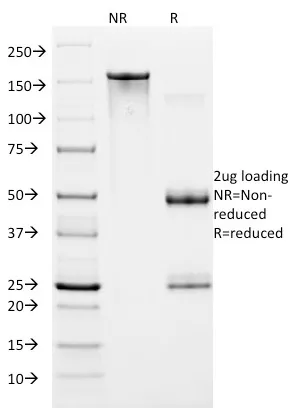Anti-HIF1 alpha (Hypoxia-Inducible Factor 1-alpha)(ESEE122), CF640R conjugate
CAT:
37-BNC401574-500
Size:
500 µL
Price:
Ask
- Availability: 24/48H Stock Items & 2 to 6 Weeks non Stock Items.
- Dry Ice Shipment: No




Anti-HIF1 alpha (Hypoxia-Inducible Factor 1-alpha)(ESEE122), CF640R conjugate
- Description: HIF1 (hypoxia-inducible factor 1), a heterodimeric transcription factor complex central to cellular response to hypoxia, consists of two subunits (HIF-1 alpha and HIF-1 beta) which are basic helix-loop-helix proteins of the PAS (Per, ARNT, Sim) family. Expression of HIF-1 alpha protein is regulated by cellular oxygen level alterations as well as in oxygen-independent manner via different cytokines (through the PI3K-AKT-mTOR pathway), growth factors, oncogenic activation, or loss of tumor suppressor function etc. In normoxic cells, HIF-1 alpha is proline hydroxylated leading to a conformational change that promotes its binding to the VLH (von Hippel Lindau) protein E3 ligase complex; ubiquitination and followed by rapid proteasomal degradation. Hypoxia as well as chemical hydroxylase inhibitors (desferrioxamine, cobalt etc. ) inhibit HIF-1 alpha degradation and lead to its accumulation in the cells, whereas, contrastingly, HIF-1 beta/ARNT (AhR nuclear translocator) remains stable under both conditions. Besides their critical role in hypoxic response, HIF1s regulates the transcription of genes responsible for angiogenesis, erythropoiesis/iron-metabolism, glucose metabolism, cell proliferation/survival, adipogenesis, carotid body formation, B lymphocyte development and immune reactions. Primary antibodies are available purified, or with a selection of fluorescent CF® Dyes and other labels. CF® Dyes offer exceptional brightness and photostability. Note: Conjugates of blue fluorescent dyes like CF®405S and CF®405M are not recommended for detecting low abundance targets, because blue dyes have lower fluorescence and can give higher non-specific background than other dye colors.
- Synonyms: ARNT-interacting protein; Basic-helix-loop-helix-PAS protein MOP1; Class E basic helix-loop-helix protein 78 (bHLHe78); Member of PAS superfamily 1 (MOP1); PAS domain-containing protein 8 (PASD8)
- CAS Number: 9007-83-4
- UNSPSC: 41116161
- UNSPSC Description: Primary and secondary antibodies for multiple methodology immunostaining detection application
- Gene Name: HIF1A
- Gene ID: 3091
- NCBI Gene ID: 597216
- UniProt: Q16665
- Cellular Locus: Nucleus & cytoplasm
- Host: Mouse
- Species Reactivity: Cow, Dog, Human, Mouse, Rat
- Immunogen: GST-human HIF-1A amino acids 329-530 fusion protein
- Target Antigen: HIF1 Alpha
- Clonality: Monoclonal
- Isotype: IgG1 κ
- Clone: ESEE122
- Conjugation: CF640R
- Source: Animal
- Applications: IHC, FFPE (published) | WB (published)
- Validated Applications: IHC, FFPE, WB
- Positive Control: Cobalt chloride treated HeLa cells. Colon, Renal, Breast or Bladder Carcinomas.
- Concentration: 0.1 mg/mL
- Buffer: PBS, 0.1% BSA, 0.05% azide
- Molecular Weight: 92-110 kDa
- Additionnal Information: ELISA: For coating, purchase antibody without BSA; Flow cytometry: 0.5-1 ug/million cells; Immunofluorescence: 0.5-1 ug/mL; Optimal dilution for a specific application should be determined.|Higher concentration may be required for direct detection using primary antibody conjugates than for indirect detection with secondary antibody
- References & Citations: Note: References for this clone sold by other suppliers may be listed for expected applications. Cancer (2006) 107(4): 757-766. (IHC, FFPE) Biol Pharm Bull (2017) 40(1): 82-87. (WB)
- Shipping Conditions: Room temperature
- Storage Conditions: 4°C; Protect from light; Stable at room temperature or 37°C (98°F) for 7 days.
- Shelf Life: 2 years
